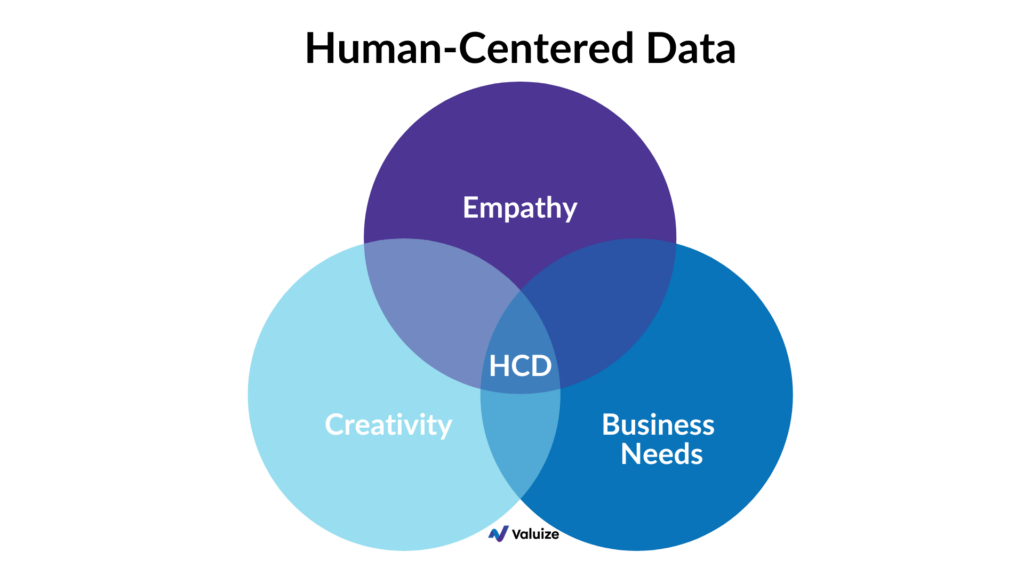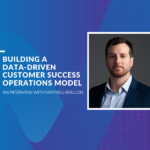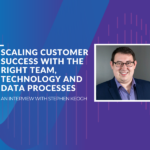A Human-First Approach To Data
Over 2.5 quintillion bytes of data are created every single day – that’s 2.5 followed by a staggering 18 zeros (DOMO, 2019)! While we live in an era of information abundance, organizations aren’t able to leverage the full potential of their data to drive value for their business, employees and customers without the right systems and processes in place. As economic challenges and customer expectations become more complicated, it’s clear that we need to approach data in a fundamentally different way, focusing on the values, needs and expectations of people.
In this article, we unpack an innovative approach to human-centered data design and outline the prevailing challenges that leaders must overcome in order to spearhead a human-centered data transformation that maximizes customer value delivery and achievement.
The Fundamentals Of Human-Centered Data Design
Human-centered design is a problem-solving approach that is laser-focused on understanding the perspective of the person experiencing a problem and whether a solution is actually addressing their needs. At its core, this approach ensures that the very people who are experiencing the problem are a constant and essential part of the overall solution design process. While this concept isn’t new, its application in data science is often overlooked.
Currently, much of the data science in B2B technology companies is model-centered, focused on finding a model that can most accurately predict something, such as churn. On the contrary, a human-centered approach shifts this conversation to focus on the people most affected by the problem; what can we do so that people involved can achieve the best outcomes? By incorporating human-centered design practices into data science, you can develop human-centered algorithms and create data models that truly meet the needs of the people impacted, ensuring that you’re maximizing your customers’ value realization and your team’s effectiveness.
The 3 Core Principles Of Human-Centered Data Design
A human-centered approach to data is a combination of three fundamental principles: empathy, creativity and business needs.

Empathy
The first step to approaching human-centered data design is to understand the needs, challenges and goals of the people you’re designing for. You need to genuinely care about the people you design for in order to build solutions that align with the needs of your stakeholders. Develop empathy by immersing yourself in the community that will use your data-driven insights and get their perspective in their own words; this approach will help you focus on the goal without being derailed by technical requirements. By directly involving all of your stakeholders in the end-to-end process, you can better translate end-user needs into impactful data experiences.
Creativity
Creativity and thinking outside the box is often more difficult to achieve than leaders expect. Giving team members time to brainstorm, ideate and play is often seen as a luxury and commonly overlooked when deadlines or budgets are tight. However, this process is also crucial to fostering real innovation and finding creative ways to solve users’ problems. To foster this creativity and cultivate true innovation, we recommend incorporating a brainstorming and ideation phase as part of every project.
Business Needs
While empathy and creativity are important components of human-centered data design, you also need to ensure that your insights and algorithms are designed to deliver optimal value. To make your human-centered approach truly successful, you also need to factor in your business goals as well as your customers’ business’ needs. By never losing sight of the people in the mix and the outcomes they’re striving to achieve, you can ensure that you’re creating something truly valuable for them.
The Challenges Of Human-Centered Data
A human-centered approach to data design requires participation from stakeholders throughout the entire process, from ideation and design through to implementation and measurement. While this is necessary to create a valuable solution or process, it also opens the door to common challenges associated with human involvement in data.
First and foremost, data analysis itself can be a scary prospect for people and companies. The sheer volume of data, coupled with messy data that may be inaccurate, mislabelled or out-of-date, can be overwhelming and trigger a fear response in the people who need to use it. Sometimes, people avoid looking at data because they’re afraid of what it may reveal or they know what the data will say but want to avoid dealing with the results. In these instances, many people resort to gut-feeling; “I feel like this customer is fine,” or “I feel like our team is focused on the right thing.” In this process, it becomes easy to ignore some of the critical issues and miss out on discovering improvement opportunities within your business.
Other ever-present challenges are the human emotions and biases associated with data that can often cloud your team’s, or your customer’s, judgment. There are many examples, and some we’ve personally witnessed, of people latching onto illogical conclusions because of an emotional attachment to data. One specific example was a client that measured value in literal ROI (very handy). When we analyzed their data, we found that some customers, in spite of above-threshold ROI results, would be at significant risk of churn.
Upon further research, we discovered that the customers who had high risk of churn in spite of glowing ROI were all on the new contract model, which stipulated an upper limit to the number of contests the customer could run. As a result, customers ended up focusing on an artificial measure of value: the maximum number of contests. Their emotional connection to being below the maximum made them feel that value was being left on the table, even when the true value (ROI) they were receiving was among the highest of all customers.
Lead With A Human-First Approach
B2B technology companies that are seeking to drive unparalleled value and Net Dollar Retention must first focus on driving value for their people. By championing human-centered data design, you can vastly improve your organization’s ability to meet the needs, expectations and goals of the people most impacted by your processes, optimizing your team’s ability to drive value realization for your customers.
How can you leverage the power of human-centered data analytics to build value-driven relationships with your customers? Watch our recent session of On Operations with host and Valuize CCO, Emily Ryan, and Acorn’s Minister of Momentum, Mike Zawitkowski, as they share how you can leverage data to personalize your customer journey, enhance your customer engagement strategy, and speed up your customers’ paths to value realization and success.





